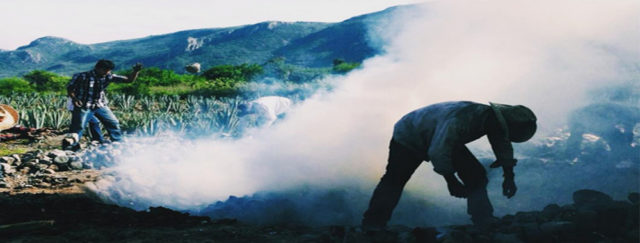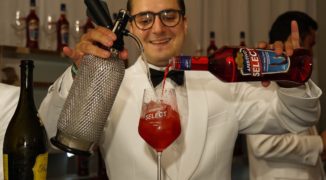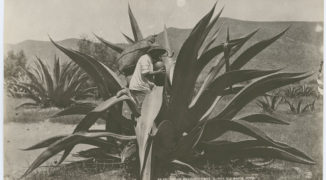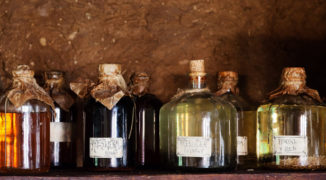For some, it’s the scent of smoked bacon garnish. For others, it’s the seductive white vapor dancing like a genie from its rocks glass. With so many evocative, char-flavored libations showing up on menus, many a cocktail enthusiast has experienced that existential moment: Just how did our cocktails get so smoky?
Let’s start with the more recent side of history. The smoky trend got its start in 2007, when New York barkeep Eben Freeman conjured up the much-loved Waylon, a mix of smoked Coca-Cola and bourbon. It was a slow beginning, but smoked cocktail ingredients have been turning up ever since. Smoked ice and rim salt. Tobacco-infused syrup. Smoked teas, tinctures, and herbs (including, yes, that herb). Almost every standard recipe has basked in the smoky spotlight, from martinis and Bloody Marys, to Old Fashioneds and margaritas, in addition to seasonal creations by beverage directors around the country.
Smoke guns and mini blowtorches make for fine modern bar tools. But whisky expert Dave Broom (author of World Atlas of Whisky and Whisky: The Manual) reminds us that the roots of liquid smoke started long ago, mostly with two key spirits—peaty Scotch whisky and mezcal from Oaxaca. The distinctive flavors inherent to each are derived from the production process, where raw materials barley and agave, respectively, get the slow roast treatment.
Early origins
“From a surprisingly early time,” Broom says, “peat was used for quality reasons.” Brown and soil-like, peat beds take thousands of years to form, made up of decomposed moss and vegetable matter. Centuries before peat became a popular garden soil add-in, top scientists celebrated it as the best fuel for malting, encouraging its use to dry barley. Phenols released in the burning peat create oils in the smoke that help form the whisky’s character.
With mezcal, the peat and kiln are replaced by a huge underground oven, or fire pit. And agave. Plenty of agave.
Dr. Iván Saldaña Oyarzábal runs the website The Anatomy of Mezcal, holds a Ph.D. in biochemistry and founded Montelobos Mezcal. In Oaxaca, where 93 percent of mezcal is produced, traditional methods dictate large fire pits be heated by hardwood (pine or Mexican oak) covered in volcanic rocks. “The rocks absorb so much heat, they will eventually look red and orange,” Saldaña says. The smoke released during the four-day cooking process lends the spirit its spicy, chocolatey notes.
For both whisky and mezcal, smoke may be key, but it doesn’t deserve all the credit. And though it’s used widely, “smoke” is not an all-encompassing term. What makes a smoky whisky work well is “everything that goes around the peatiness,” Broom says. “Smoke always has a drying effect in the mouth. For a smoky whisky to be balanced, you need sweetness.” That’s where the rest of production—fermentation, distillation—comes in.
Likewise, Saldaña acknowledges the role that agave and fermentation play in creating a blanco mezcal like the one produced at Montelobos. Green agave contributes bright, citrusy notes, courtesy of raw elements that survive the cooking process. The cooked agave offers a more rounded, caramel flavor. Yeast produced during fermentation gives off a ripe, fruity aroma. The intensity and flavor of smoke in any given mezcal can change with the type of wood used in the fire pit, how dry or damp it is, the proportions of wood to agave, and cooking time.
 Agave is cooked over a hardwood burning fire, covered in volcanic rocks to make Montelobos mezcal.
Agave is cooked over a hardwood burning fire, covered in volcanic rocks to make Montelobos mezcal.
On the frontlines
Broom says that over time, human beings’ palates have developed to actually desire smoke. Most cultures have dishes that are centered around grilling or barbecue. If drinks are largely driven by the food we eat, it’s no wonder we’ve found ways to activate those senses in liquid form. Still, those who’ve taken the smoke plunge at their favorite cocktail bar know that a little goes a long way. With smoke, you can definitely have too much of a good thing.
Bartenders would do well to “study smoky spirits on their own,” Broom says. “With some smoky spirits, the smoke appears immediately. Others, you pick it up in the middle of the palate.”
Saldaña cautions that the smokiness of mezcal can be hard to predict once it’s mixed in a cocktail. The culprit is dilution. “The smoke is relative on the matrix of alcohol and water,” says the biochemist-distiller. “You may have a 45 proof mezcal, with nice, balanced smoke. But when you mix that product and the alcohol is reduced, suddenly the smoke screams in your face.”
That’s why it it’s so common to see cocktails use a tequila-mezcal mash-up: The bartender is trying to control for the mezcal’s tricky dragon breath. “The spirit-smoke integration is the master distiller’s job,” Saldaña continues. “If they did their job well, a bartender should be able to use mezcal as a core spirit.”
Both Broom and Saldaña indicated they prefer their smoke be inherent to the spirit. But why should mezcal and Scotch have all the fun?
Trevor Frye, beverage director at Washington D.C.’s Jack Rose Dining Saloon and its tiny cocktail bar Dram + Grain, uses a smoking gun for his Ode to Omaha. The rum-based drink is a nod to the Nebraska bar Berry & Rye, where he and buddy first started experimenting with smoke. There were challenges.
“We thought smoky drinks were interesting, but generally speaking, they weren’t executed well. The smoke either overpowered the palate, or was just for show.”
The Ode to Omaha, similar to a rum Old Fashioned, has a lot of fanfare, Frye admits. But it’s “shtick with a purpose.” Using wood chips and a dry smoker, Frye directs a hose of smoke into a glass vessel of Thomas Tew Rum, fruit-based syrup, and Jerry Thomas bitters, stopping it with a cork. “The smoke mixes well with rum—it plays off the rum’s woody spice,” Frye says.
The smoky future
While there are some differences in mezcal production, Saldaña says there aren’t any major variations taking place in the cooking process right now. With whiskey, however, Broom has taken note of several distillers who proudly define their product as a “not Scotch” option. They’ve incorporated their country’s terroir in the malting process, so the whiskey flavors depend on the raw materials used to smoke the barley.
In Denmark, Fary Lochan uses nettles, which give the whiskey a grassy, herbal flavor. Flóki, a single malt from Iceland, smokes the barley with sheep dung. “The sample I had was only five years old, but it was quite farm-yardy and vegetal,” Broom recalls. Down in Australia, Lark Distillery uses a peat that reminded Broom of eucalyptus—a clean, woodsy flavor. A thick, hazy future such as this never seemed so bright.





